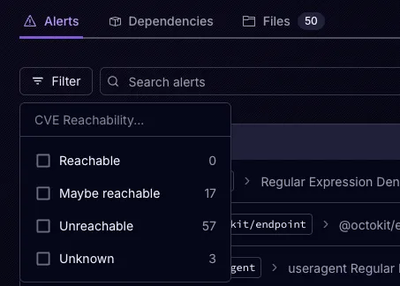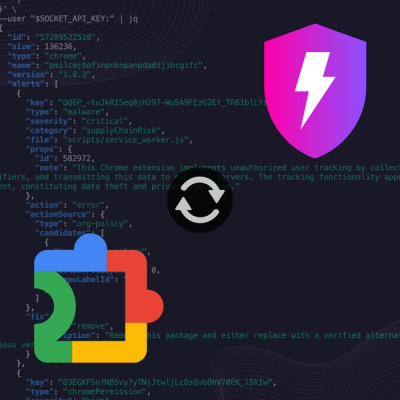
Product
Introducing Rust Support in Socket
Socket now supports Rust and Cargo, offering package search for all users and experimental SBOM generation for enterprise projects.
redis4goose
Advanced tools
Simulate mongo command on redis
This guide provides comprehensive instructions on how to use the RedisModel class, which offers MongoDB-like operations for working with Redis.
Before using the RedisModel, make sure you have the required dependencies installed:
npm install ioredis uuid
To use the RedisModel, first import it and create an instance:
const RedisModel = require('./RedisModel');
const userSchema = {
name: { type: 'string' },
age: { type: 'number' },
email: { type: 'string' }
};
// Default initialization (uses default Redis connection settings)
const UserModel = new RedisModel('User', userSchema);
// Initialization with custom Redis options
const redisOptions = {
host: 'your-redis-host',
port: 6379,
password: 'your-redis-password',
// Add other options as needed
};
const CustomUserModel = new RedisModel('User', userSchema, redisOptions);
To create a new document:
const newUser = await UserModel.create({
name: 'John Doe',
age: 30,
email: 'john@example.com'
});
console.log(newUser); // { id: '...', name: 'John Doe', age: 30, email: 'john@example.com' }
To find a document by ID:
const user = await UserModel.findById('some-uuid');
console.log(user);
To find multiple documents:
const users = await UserModel.find({ age: { $gte: 18 } });
console.log(users);
To find a single document:
const user = await UserModel.findOne({ email: 'john@example.com' });
console.log(user);
To update a single document:
const updated = await UserModel.updateOne(
{ email: 'john@example.com' },
{ age: 31 }
);
console.log(updated); // true if a document was updated, false otherwise
To update multiple documents:
const result = await UserModel.updateMany(
{ age: { $lt: 18 } },
{ status: 'minor' }
);
console.log(result.modifiedCount);
To delete a single document:
const deleted = await UserModel.deleteOne({ email: 'john@example.com' });
console.log(deleted); // true if a document was deleted, false otherwise
To delete multiple documents:
const result = await UserModel.deleteMany({ age: { $lt: 18 } });
console.log(result.deletedCount);
The find method supports various query operations:
// Greater than
const adultsOnly = await UserModel.find({ age: { $gt: 18 } });
// Greater than or equal to
const adultsAndTeens = await UserModel.find({ age: { $gte: 13 } });
// Less than
const minors = await UserModel.find({ age: { $lt: 18 } });
// Less than or equal to
const notSeniors = await UserModel.find({ age: { $lte: 65 } });
// Not equal to
const notJohn = await UserModel.find({ name: { $ne: 'John' } });
// In array
const specificAges = await UserModel.find({ age: { $in: [20, 30, 40] } });
You can also use options for pagination and sorting:
const options = {
limit: 10,
skip: 20,
sort: 'age:desc'
};
const users = await UserModel.find({}, options);
To count documents matching a query:
const adultCount = await UserModel.countDocuments({ age: { $gte: 18 } });
console.log(adultCount);
The RedisModel will throw errors for invalid data types. Always use try-catch blocks:
try {
await UserModel.create({ name: 'John', age: '30' }); // This will throw an error
} catch (error) {
console.error('Error creating user:', error.message);
}
Remember to handle potential Redis connection errors as well.
When you're done using the RedisModel, it's important to close the connection to free up resources:
await UserModel.close();
This guide covers the basic usage of the RedisModel class. For more advanced use cases or specific Redis operations not covered by this model, you may need to extend the class or use the Redis client directly.
FAQs
Simulate mongo command on redis
The npm package redis4goose receives a total of 0 weekly downloads. As such, redis4goose popularity was classified as not popular.
We found that redis4goose demonstrated a healthy version release cadence and project activity because the last version was released less than a year ago. It has 1 open source maintainer collaborating on the project.
Did you know?

Socket for GitHub automatically highlights issues in each pull request and monitors the health of all your open source dependencies. Discover the contents of your packages and block harmful activity before you install or update your dependencies.

Product
Socket now supports Rust and Cargo, offering package search for all users and experimental SBOM generation for enterprise projects.

Product
Socket’s precomputed reachability slashes false positives by flagging up to 80% of vulnerabilities as irrelevant, with no setup and instant results.

Product
Socket is launching experimental protection for Chrome extensions, scanning for malware and risky permissions to prevent silent supply chain attacks.